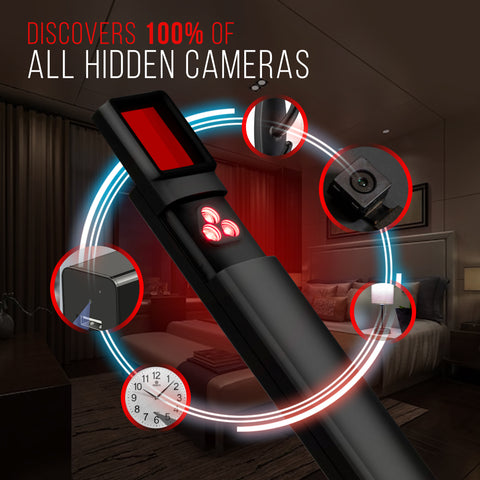Protect Your Privacy: How to Find and Remove Hidden Cameras in Your Home
In today's digital age, privacy is more important than ever. With the advancement of technology, hidden cameras are becoming smaller and more discreet, making it easier for someone to invade your privacy without your knowledge. Whether you are renting a new apartment, staying at an Airbnb, or just want to ensure your home is free from unwanted surveillance, it's crucial to know how to find and remove hidden cameras. This article will provide you with essential tips on how to protect your privacy and maintain a safe space in your home.
Types of Hidden Cameras
Before you start searching for hidden cameras in your home, it's essential to understand the different types of devices that could be used for surveillance:
Wired Hidden Cameras
- Connected to a power source and can transmit video feed over cables.
- Can be hidden in everyday items like smoke detectors, wall clocks, or electrical outlets.
Wireless Hidden Cameras
- Battery-powered and transmit video feed wirelessly.
- Can be disguised as various objects, such as picture frames, USB chargers, or even plants.
How to Find Hidden Cameras
Perform a Physical Inspection
- Check common hiding spots like smoke detectors, wall decorations, and electrical outlets.
- Look for any unusual wires or cables that don't seem to belong.
- Use a flashlight to search for hidden cameras in dark areas.
Scan for RF Signals
- Use a radio frequency (RF) detector to sweep the room for wireless cameras.
- Move the detector around the room while paying attention to any sudden spikes in signal.
- RF detectors can help you locate cameras that are transmitting wireless signals.
Check for Camera Lens Reflections
- Turn off all lights in the room and use a flashlight or smartphone camera to scan for reflections.
- Hidden camera lenses will typically reflect light, making them easier to spot in a dark environment.
- Look for small glimmers of light coming from unexpected places.
Removing Hidden Cameras
Disable the Camera
- If you find a hidden camera, the first step is to disable it to stop any further recording or transmission of video feed.
- Disconnect the power source or remove the batteries from the camera.
- This will prevent any unauthorized monitoring from taking place.
Disconnect or Remove the Camera
- Once the camera is disabled, carefully disconnect it from its hiding spot.
- Remove the camera from the premises to ensure that your privacy is fully restored.
- Dispose of the camera properly to prevent any potential data breaches.
Seek Professional Help
- If you are unsure about how to remove a hidden camera safely, consider seeking the assistance of a professional.
- Security experts or private investigators have the knowledge and experience to detect and remove hidden cameras effectively.
- They can also provide advice on how to prevent future surveillance attempts in your home.
Preventative Measures
Protect Your Privacy
- Regularly inspect your home for any signs of unauthorized surveillance.
- Be cautious when staying in unfamiliar places or using public restrooms.
- Keep sensitive conversations private and avoid discussing confidential information in front of unknown devices.
Use Privacy Devices
- Consider using privacy devices like camera covers, signal jammers, or noise generators to protect your privacy.
- Invest in a good quality security system for your home to deter potential intruders.
- Enable encryption and two-factor authentication on your devices to prevent unauthorized access.
Stay Informed
- Stay updated on the latest privacy laws and regulations in your area to know your rights as a homeowner.
- Educate yourself on cybersecurity best practices and how to secure your devices from potential hacks.
- Join online communities or forums to share experiences and learn from others about protecting privacy.
Glamour Meets Expertise: Secrets of a Makeup Artist Revealed
Makeup artists are the magicians of the beauty world, transforming faces with their expert hands and creative vision. Their skills can turn an ordinary look into a glamorous masterpiece, leaving us in awe of their talent. But what secrets do these makeup artists hold? In this article, we will delve into the world of makeup artistry and uncover some of the tips and tricks that these professionals use to create stunning looks.
The Art of Makeup
Makeup is not just about applying products to the face – it is an art form that requires skill, creativity, and an understanding of facial features. Makeup artists are trained in techniques that enhance natural beauty and create a flawless finish. Here are some of the secrets that makeup artists use to achieve stunning results:
Prepping the Skin
- Before applying any makeup, it is essential to prep the skin to create a smooth canvas for the products.
- Makeup artists often use moisturizers, primers, and serums to hydrate the skin and create a dewy glow.
- Using a good skincare routine before applying makeup can make a significant difference in the final look.
Color Theory
- Understanding color theory is crucial for makeup artists, as it allows them to create harmonious looks that complement their clients' features.
- Knowing which colors work best for different skin tones and eye colors is essential for creating a balanced and beautiful makeup look.
- Makeup artists use color theory to create depth, definition, and dimension on the face.
The Power of Tools
Makeup artists have an array of tools at their disposal, from brushes and sponges to palettes and pencils. These tools are essential for creating precise and flawless makeup looks. Here are some secrets of a makeup artist when it comes to tools:
Choosing the Right Brushes
- Makeup artists know that the right brush can make all the difference in how the makeup is applied.
- They use different brushes for different purposes, such as blending, contouring, and highlighting.
- Investing in high-quality brushes is essential for achieving professional-looking results.
The Magic of Sponges
- Makeup sponges are a favorite tool of many makeup artists, as they can create a flawless finish when applying foundation and concealer.
- Sponges can also be used to blend out harsh lines and create a seamless makeup look.
- Makeup artists often dampen the sponge before using it to create a more natural and dewy finish.
Creating the Look
One of the secrets of a makeup artist is their ability to create a wide range of looks, from natural and understated to bold and dramatic. Here are some tips for creating different makeup looks:
Enhancing Natural Beauty
- Makeup artists know how to enhance their clients' natural beauty without overpowering their features.
- They use techniques such as highlighting, contouring, and defining to bring out the best in their clients' faces.
- Creating a natural makeup look often involves using neutral tones and subtle techniques to enhance the skin's radiance.
Going Glamorous
- For a glamorous look, makeup artists often focus on bold lips, dramatic eyes, and flawless skin.
- They use techniques such as cut creases, winged eyeliner, and bold lip colors to create a striking makeup look.
- Glamorous makeup looks often involve using shimmer and glitter to add a touch of glamour and sophistication.
Conclusion
Makeup artists are skilled professionals who have a deep understanding of beauty and artistry. Their secrets lie in their ability to enhance natural beauty, use color theory to create harmonious looks, and choose the right tools for the job. Whether creating a natural everyday look or a glamorous red carpet style, makeup artists have the expertise to transform faces and leave us feeling glamorous and confident.
Top Tips for Choosing the Best Personal Injury Lawyer in Your Area
When you've been injured in an accident due to someone else's negligence, finding the right personal injury lawyer can make all the difference in the outcome of your case. With so many lawyers to choose from, it can be overwhelming to know where to start. Here are some top tips to help you select the best personal injury lawyer in your area.
Do Your Research
Before making a decision, take the time to research and consider the following:
Experience and Expertise
- Look for a lawyer who specializes in personal injury cases.
- Check their track record of success in similar cases.
Reputation
- Read online reviews and testimonials from past clients.
- Check with your state's bar association for any disciplinary actions.
Communication
- Ensure the lawyer communicates clearly and promptly.
- Ask about their preferred method of communication and response time.
Meet in Person
It's essential to meet potential lawyers in person to get a sense of their personality and communication style. During the initial consultation, consider the following:
Ask Questions
- Inquire about their experience with personal injury cases.
- Discuss their strategy for handling your case.
- Ask about their fee structure and billing practices.
Trust Your Instincts
Pay attention to how comfortable you feel with the lawyer. Trust your instincts and choose someone you feel confident and at ease working with.
Consider Accessibility
Accessibility is crucial when it comes to working with a personal injury lawyer. Make sure to consider the following factors:
Location
- Choose a lawyer who is conveniently located near you.
- Ensure easy access to their office for meetings and consultations.
Availability
- Ask about the lawyer's availability to take on your case.
- Clarify how and when you can reach them for updates or questions.
Review Fee Structure
Understanding the lawyer's fee structure is essential to avoid any surprises down the road. Consider the following when reviewing their fee agreement:
Contingency Fee
- Many personal injury lawyers work on a contingency fee basis.
- Understand the percentage the lawyer will take if you win your case.
Additional Costs
- Ask about any additional costs you may be responsible for, such as court fees or expert witness fees.
- Clarify how expenses will be handled if you do not win your case.
Get Recommendations
One of the best ways to find a reliable personal injury lawyer is to ask for recommendations from trusted sources. Consider the following when seeking recommendations:
Friends and Family
- Ask friends or family members who have been in a similar situation for their recommendations.
- Get insights into their experience working with the lawyer.
Other Lawyers
- Consult with other lawyers you may know in different fields for referrals.
- Legal professionals can often provide valuable insights into the reputation of their peers.
Verify Credentials
Before making your final decision, make sure to verify the lawyer's credentials and qualifications. Consider the following:
Licensing
- Ensure the lawyer is licensed to practice law in your state.
- Check with the state bar association for their current status.
Certifications
- Look for any additional certifications or memberships in relevant organizations.
- Consider any accolades or awards the lawyer has received in their field.
By following these top tips for choosing the best personal injury lawyer in your area, you can make an informed decision and increase your chances of a successful outcome in your case.
The Future of Learning: Exploring the Benefits of an Online Science Tutor
As technology continues to advance, the field of education is transforming. One of the most significant changes is the rise of online tutoring, which offers students the opportunity to learn from qualified tutors in a virtual setting. In the realm of science education, online tutoring is becoming increasingly popular as students seek additional support and resources to excel in their studies. In this article, we will explore the benefits of an online science tutor and how this mode of learning can shape the future of education.
The Convenience of Online Science Tutoring
One of the primary advantages of online science tutoring is the convenience it offers to students. With traditional tutoring methods, students often have to travel to a physical location for their tutoring sessions, which can be time-consuming and costly. Online tutoring eliminates the need for travel, allowing students to access tutoring sessions from the comfort of their own homes. This convenience makes it easier for students to fit tutoring sessions into their busy schedules, leading to better time management and improved academic performance.
Key benefits of online science tutoring include:
- Flexibility to schedule tutoring sessions at convenient times
- Elimination of travel time and costs
- Access to a global network of qualified science tutors
- Ability to review session recordings for enhanced learning
Personalized Learning Experience
Another significant benefit of online science tutoring is the ability to provide personalized learning experiences for students. Online tutors can tailor their teaching methods to suit the individual learning styles and needs of each student. This personalized approach can help students grasp difficult scientific concepts more effectively and build a strong foundation in science education.
Key features of personalized online science tutoring include:
- Customized lesson plans based on student's learning goals
- One-on-one attention from experienced science tutors
- Instant feedback and guidance on problem-solving techniques
- Adaptive learning tools to cater to student's strengths and weaknesses
Interactive Learning Tools
Online science tutoring platforms often incorporate interactive learning tools to engage students and enhance their learning experience. These tools can range from virtual simulations and multimedia resources to online quizzes and games. By incorporating interactive elements into tutoring sessions, online science tutors can make learning more enjoyable and effective for students.
Examples of interactive learning tools used in online science tutoring:
- Virtual laboratory simulations for hands-on experiments
- Multimedia presentations to explain complex scientific concepts
- Online quizzes and assessments to test student understanding
- Collaborative whiteboard tools for real-time problem-solving
24/7 Access to Learning Resources
Online science tutoring provides students with 24/7 access to a wealth of learning resources and materials. This round-the-clock availability allows students to review lesson materials, practice problems, and seek help from their tutors whenever they need it. With online tutoring, students no longer have to wait for their next scheduled session to clarify doubts or seek additional assistance.
Benefits of 24/7 access to learning resources in online science tutoring:
- Ability to revisit previous tutoring sessions for reinforcement
- Access to a wide range of study materials and practice exercises
- Instant messaging and email support for quick queries
- Self-paced learning opportunities for independent study
Conclusion
As we look towards the future of learning, online science tutoring emerges as a valuable tool for students looking to excel in their science education. The convenience, personalized learning experience, interactive tools, and 24/7 access to resources offered by online tutoring can significantly enhance students' understanding of scientific concepts and improve their academic performance. By leveraging the benefits of an online science tutor, students can unlock their full potential and embark on a successful learning journey in the fascinating world of science.
Cheers to the Night: Must-Visit Bars in Soho for Every Occasion

Image Source: Google
Looking to unwind after a long day at work, celebrate a special occasion, or simply enjoy a night out with friends? Soho in London is the perfect destination for your next night out.
With its vibrant atmosphere, diverse range of bars, and unique charm, Soho offers something for everyone. Whether you're in the mood for craft cocktails, a cozy wine bar, or a lively dance floor, Soho has it all. Here are some must-visit bars in Soho for every occasion.
Best Bars for a Cozy Evening
1. Milk & Honey
- Intimate speakeasy-style bar
- Extensive cocktail menu
- Reservations recommended
2. Cahoots
- 1940s-themed underground bar
- Unique cocktails served in quirky containers
- Live music and entertainment
Top Bars for a Celebration
1. Bar Termini
- Classic Italian cocktails
- Perfect for a sophisticated celebration
- Small and intimate setting
2. Experimental Cocktail Club
- Chic and stylish cocktail bar
- Creative and innovative cocktail menu
- Great for celebrating special occasions
Must-Visit Bars for a Night of Dancing
1. The Box
- Exclusive nightclub with live performances
- Known for its risqué and avant-garde shows
- Reservations required
2. Disco Bar at Old Street Records
- 70s-inspired disco bar
- Dance the night away to funk and soul music
- Great for a fun and lively night out
Bars with a View
1. Aqua Spirit
- Rooftop bar with stunning views of London
- Extensive cocktail menu
- Perfect for enjoying the city skyline
2. The Perception at W London
- Trendy bar with panoramic views
- Creative cocktails and delicious bar bites
- Great for a stylish night out
Roof Anchor Point Installation 101: Essential Steps for a Secure Setup

Image Source: Google
When it comes to working at heights, ensuring safety should be the top priority. Roof anchor points are crucial components of a fall protection system, providing a secure attachment for personal protective equipment like harnesses and lanyards. Proper installation of roof anchor points is essential to prevent accidents and protect workers. In this guide, we will outline the essential steps for a secure roof anchor point installation.
Step 1: Assessing the Roof Structure
Determine the Type of Roof
- Flat Roof: Determine if it is concrete, metal, or another material.
- Sloped Roof: Consider the pitch and material of the roof.
Locate Roof Trusses or Joists
- Identify the structural elements to ensure a secure anchor point attachment.
Step 2: Choosing the Right Anchor Point
Selecting the Type of Anchor Point
- Permanent: Installed for long-term use.
- Temporary: Portable and ideal for short-term projects.
Decide on the Number of Anchor Points Needed
- Consider the number of workers and the work area to determine the quantity.
Step 3: Installing the Anchor Points
Follow Manufacturer Guidelines
- Read and adhere to the installation instructions provided by the manufacturer.
Secure Attachment
- Use appropriate fasteners and ensure a tight fit to the roof structure.
Proper Spacing
- Ensure anchor points are adequately spaced to cover the work area effectively.
Step 4: Testing the Anchor Points
Perform a Load Test
- Simulate the weight of a worker to ensure the anchor points can support the load.
Inspect for Stability
- Check for any movement or loosening of the anchor points after installation.
Step 5: Training and Maintenance
Provide Proper Training
- Ensure workers are trained in the use of anchor points and fall protection equipment.
Regular Inspections
- Inspect anchor points periodically for signs of wear or damage.
Maintain Documentation
- Keep records of installation, inspections, and maintenance for compliance purposes.
By following these essential steps for roof anchor point installation, you can create a safe working environment for employees who need to perform tasks at heights. Remember that proper installation, testing, and maintenance are key to the effectiveness of your fall protection system.
Must-Have Furniture Pieces for Your Short Term Apartment Rental
Setting up a short-term apartment rental can be a lucrative venture, but the key to success lies in providing your guests with a comfortable and functional living space. One way to ensure that your rental stands out is by investing in the right furniture pieces. In this article, we will discuss the must-have furniture items that you should consider including in your short-term apartment rental to attract more guests and receive positive reviews.
1. Essential Furniture Pieces
Sofa Bed
- A sofa bed is a versatile piece of furniture that can serve as a comfortable seating option during the day and a cozy bed at night.
- Choose a sofa bed with a high-quality mattress to ensure a good night's sleep for your guests.
Dining Table and Chairs
- A dining table and chairs set is essential for guests who prefer to dine in the comfort of their rental.
- Opt for a table that can accommodate the maximum number of guests your rental can accommodate.
2. Functional Furniture Pieces
Storage Ottoman
- A storage ottoman not only serves as a comfortable seating option but also provides extra storage space for your guests.
- Choose an ottoman with a lift-up top to easily access the storage compartment.
Foldable Desk
- A foldable desk is a space-saving solution for guests who need to work or study during their stay.
- Look for a desk that can be easily folded and stored away when not in use.
3. Stylish Furniture Pieces
Accent Chair
- An accent chair can add a pop of color and style to your rental space.
- Choose a comfortable accent chair that complements the overall decor of the apartment.
Statement Coffee Table
- A statement coffee table can serve as a focal point in your living room area.
- Opt for a coffee table with a unique design or material to enhance the aesthetics of the space.
4. Must-Have Bedroom Furniture
Comfortable Mattress
- Invest in a high-quality mattress to ensure a comfortable night's sleep for your guests.
- Choose a mattress with medium firmness to cater to a wide range of preferences.
Nightstands
- Nightstands provide guests with a convenient place to store personal items and bedside essentials.
- Ensure that the nightstands have ample storage space and complement the bed frame.
5. Outdoor Furniture Options
Folding Chairs
- Folding chairs are a versatile option for outdoor seating on balconies or patios.
- Choose weather-resistant folding chairs that can withstand outdoor elements.
Outdoor Dining Set
- An outdoor dining set allows guests to enjoy meals al fresco during their stay.
- Opt for a compact dining set that can easily fit on a balcony or patio.
By including these must-have furniture pieces in your short-term apartment rental, you can create a comfortable and inviting space for your guests. Remember to consider the size and layout of your rental when selecting furniture items to ensure that they fit seamlessly into the space. Providing your guests with stylish, functional, and comfortable furniture will not only enhance their stay but also increase the likelihood of positive reviews and repeat bookings.
Elevate Your Home Design: Trending Ideas for Conservatory Roof Conversions

Image Source: Google
Your conservatory can be a versatile space that adds value and style to your home. One popular way to enhance the aesthetics and functionality of your conservatory is by converting the roof. If you need more information about best conservatory roof conversions, you may visit this website.
Whether you are looking to create a cozy retreat, a modern living space, or a stylish dining area, a conservatory roof conversion can transform your space and elevate your home design.
Trending Ideas for Conservatory Roof Conversions
1. Skylight Installation
- Skylights can bring in natural light and create a sense of openness in your conservatory.
- Choose energy-efficient skylights to maximize natural light while minimizing heat loss.
- Skylights come in various styles and sizes, allowing you to customize the look of your conservatory.
2. Roof Lanterns
- Roof lanterns can add a touch of elegance and sophistication to your conservatory.
- Opt for a sleek and modern design to create a contemporary look or choose a more traditional style for a classic appeal.
- Roof lanterns are a great way to enhance the architectural details of your conservatory.
3. Tiled Roof Conversion
- Replacing your conservatory roof with tiles can improve insulation and energy efficiency.
- Choose from a variety of tile materials such as slate, clay, or concrete for a unique and stylish look.
- A tiled roof conversion can give your conservatory the appearance of a traditional extension, blending seamlessly with the rest of your home.
4. Green Roof Design
- Green roofs are not only environmentally friendly but also aesthetically pleasing.
- Planting a living roof on your conservatory can provide insulation, improve air quality, and create a habitat for wildlife.
- Choose low-maintenance plants that thrive in your local climate for a sustainable and beautiful green roof design.
5. Glass Roof Conversion
- A glass roof conversion can create a contemporary and light-filled space in your conservatory.
- Opt for high-quality, energy-efficient glass to ensure proper insulation and UV protection.
- Consider adding blinds or shades for privacy and light control when opting for a glass roof conversion.
Benefits of Conservatory Roof Conversions
- Enhanced aesthetics: A roof conversion can dramatically improve the look and feel of your conservatory, adding style and sophistication to your home.
- Increased functionality: By converting your conservatory roof, you can create a more usable space that suits your lifestyle and design preferences.
- Improved insulation: Upgrading to a more energy-efficient roof can help regulate temperature and reduce energy costs.
- Added value: A well-designed conservatory with a converted roof can increase the value of your property and make it more attractive to potential buyers.
Conclusion
Transforming your conservatory roof is a great way to elevate your home design and create a stylish and functional living space. Whether you opt for skylights, roof lanterns, tiled roof conversion, green roof design, or glass roof conversion, there are plenty of trending ideas to choose from. Consider the benefits of each option and select the one that best suits your preferences and budget. With a conservatory roof conversion, you can enhance the aesthetics, functionality, and value of your home.
The Ultimate Guide to Finding Reliable Company IT Support Services

Image Source: Google
In today's digital age, having reliable IT support services for your company is essential to ensure smooth operations and minimal downtime. Whether you are a small startup or a large corporation, having a dedicated team to handle your IT needs can make a significant difference in your productivity and efficiency. Refer Link: https://coreit.ca/it-support-vancouver/
Assess Your Company's IT Needs
Before you start looking for IT support services, it is crucial to assess your company's IT needs to determine what type of support you require. Consider the following factors:
Types of IT Services Needed
- Network security
- Hardware and software maintenance
- Cloud services
- Data backup and recovery
- 24/7 support
Scalability
Consider whether the IT support services can scale with your company as it grows.
Budget
Determine how much you are willing to invest in IT support services and find a provider that fits your budget.
Research Potential IT Support Providers
Once you have identified your company's IT needs, start researching potential IT support providers. Consider the following tips:
Ask for Recommendations
Seek recommendations from other companies in your industry or network to find reputable IT support providers.
Read Reviews
Check online reviews and testimonials to gauge the reputation and reliability of the IT support providers.
Compare Services and Pricing
Request quotes from multiple IT support providers and compare their services, pricing, and contract terms before making a decision.
Interview Potential IT Support Providers
Once you have narrowed down your list of potential IT support providers, schedule interviews to learn more about their services and expertise. Consider the following factors during the interviews:
Experience and Expertise
Ask about the provider's experience in handling IT support for companies similar to yours and inquire about their certifications and qualifications.
Response Time and Availability
Inquire about the provider's response time in case of emergencies and their availability for regular maintenance and support.
Communication and Customer Service
Assess the provider's communication skills and customer service approach to ensure a smooth working relationship.
Consider Managed IT Services
Managed IT services offer proactive, ongoing support for your company's IT infrastructure. Consider the benefits of managed IT services:
- 24/7 monitoring and support
- Regular maintenance and updates
- Improved security and data protection
- Cost-effective solutions
Review Service Level Agreements (SLAs)
Before signing a contract with an IT support provider, carefully review the service level agreement (SLA) to ensure that it meets your company's needs. Consider the following aspects of the SLA:
Response Time
Clarify the provider's guaranteed response time for addressing IT issues and emergencies.
Service Scope
Ensure that the SLA clearly defines the scope of services provided by the IT support provider.
Escalation Procedures
Understand the escalation procedures for resolving complex IT issues that cannot be resolved immediately.
Finalize Your Decision
After conducting thorough research, interviews, and reviewing SLAs, finalize your decision on the IT support provider that best meets your company's needs. Consider the following before making your final decision:
- Company reputation and track record
- Compatibility with your company's culture and values
- Flexibility and scalability of services
- Overall cost and value proposition
By following this ultimate guide to finding reliable company IT support services, you can ensure that your company's IT infrastructure is in good hands, allowing you to focus on your core business activities with peace of mind.
The Ultimate Guide to Maintaining Locs While Wearing Sunglasses
Image Source: Google
Wearing sunglasses is a great way to protect your eyes from the sun's harmful rays and add a touch of style to your outfit. However, for those with locs, wearing sunglasses can sometimes be a challenge. From hair getting caught in the frames to stretching out your locs, there are a few things to consider when wearing sunglasses with locs. In this ultimate guide, we will provide you with tips and tricks on how to maintain your locs while wearing sunglasses.
Choosing the Right Sunglasses
Consider the Frame Size
- Opt for sunglasses with larger frames to ensure that your locs fit comfortably underneath.
- Avoid sunglasses with small or narrow frames that may cause your locs to get caught or tangled.
Material Matters
- Choose sunglasses made from lightweight materials to prevent them from putting too much pressure on your locs.
- Avoid sunglasses with tight temples that can cause discomfort and pull on your locs.
Preventing Damage to Your Locs
Protective Styles
- Consider wearing your locs in a protective style such as a bun or updo to minimize contact with the sunglasses.
- Use hairpins or clips to secure your locs in place and prevent them from getting caught in the frames.
Satin Lining
- Invest in sunglasses with a satin lining to reduce friction and prevent your locs from getting damaged.
- You can also sew a satin lining onto your sunglasses for added protection.
Maintaining Your Locs
Regular Trims
- Visit your hairstylist regularly for trims to prevent split ends and breakage, especially if you wear sunglasses often.
- Trimming your locs will also help them maintain their shape and prevent them from getting caught in the frames.
Moisturize
- Keep your locs moisturized to prevent them from drying out and becoming brittle.
- Use a leave-in conditioner or oil to hydrate your locs and keep them healthy and strong.
Cleaning Your Sunglasses
Regular Cleaning
- Use a microfiber cloth to gently wipe down your sunglasses and remove any dirt or debris.
- Avoid using harsh chemicals or abrasive materials that can damage the lenses or frames.
Storage
- Store your sunglasses in a protective case when not in use to prevent them from getting scratched or damaged.
- Avoid leaving your sunglasses in direct sunlight or high temperatures as this can cause warping or discoloration.
Additional Tips
Choose the Right Fit
- Make sure your sunglasses fit comfortably on your face without sliding down or feeling too tight.
- Adjust the nose pads and temples to customize the fit and prevent them from pulling on your locs.
Invest in Quality
- Opt for high-quality sunglasses that are durable and designed to last, reducing the risk of damage to your locs.
- Consider polarized lenses to reduce glare and protect your eyes from UV rays.
By following these tips and tricks, you can enjoy wearing sunglasses while keeping your locs healthy and looking their best. Remember to choose the right sunglasses, prevent damage to your locs, maintain your locs properly, clean your sunglasses regularly, and consider additional tips for a stress-free experience. With the right care and attention, you can rock your sunglasses with confidence and style!






